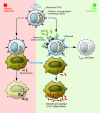Anti-TNF immunotherapy and tuberculosis reactivation: another mechanism revealed
- PMID: 19422095
- PMCID: PMC2673853
- DOI: 10.1172/jci39143
Anti-TNF immunotherapy and tuberculosis reactivation: another mechanism revealed
Abstract
Anti-TNF immunotherapy has revolutionized the treatment of some inflammatory diseases, such as RA. However, a major concern is that patients receiving this therapy have an increased risk of fungal and bacterial infection, particularly of reactivating latent tuberculosis (TB). In this issue of the JCI, in an effort to understand how anti-TNF immunotherapy affects host mechanisms required to control TB, Bruns and colleagues examined the effects of the anti-TNF therapeutic infliximab on Mycobacterium tuberculosis-specific human lymphocytes (see the related article beginning on page 1167). The authors report that a granulysin-expressing CD45RA+ subset of effector memory CD8+ T cells that contributes to the killing of intracellular M. tuberculosis is depleted in vivo by infliximab in patients with RA, and that these cells are susceptible to complement-mediated lysis in the presence of infliximab in vitro. The study provides insight into host defense mechanisms that act to control TB infection and how they are affected during anti-TNF immunotherapy for autoimmune disease.
Figures

Comment on
-
Anti-TNF immunotherapy reduces CD8+ T cell-mediated antimicrobial activity against Mycobacterium tuberculosis in humans.J Clin Invest. 2009 May;119(5):1167-77. doi: 10.1172/JCI38482. Epub 2009 Apr 20. J Clin Invest. 2009. PMID: 19381021 Free PMC article.
References
Publication types
MeSH terms
Substances
LinkOut - more resources
Full Text Sources
Medical
Research Materials

